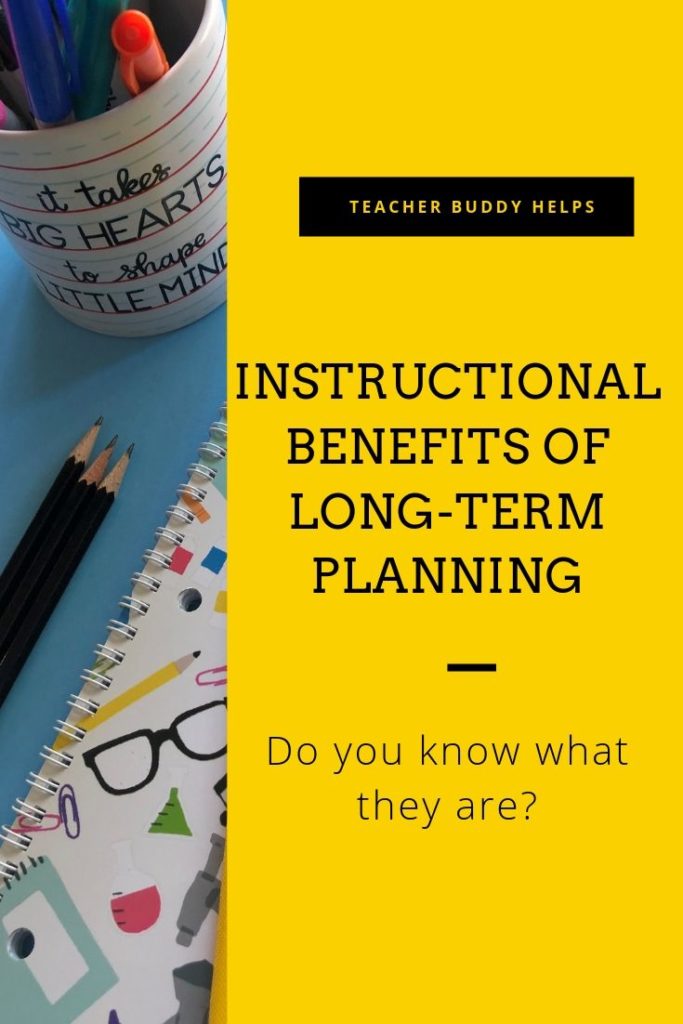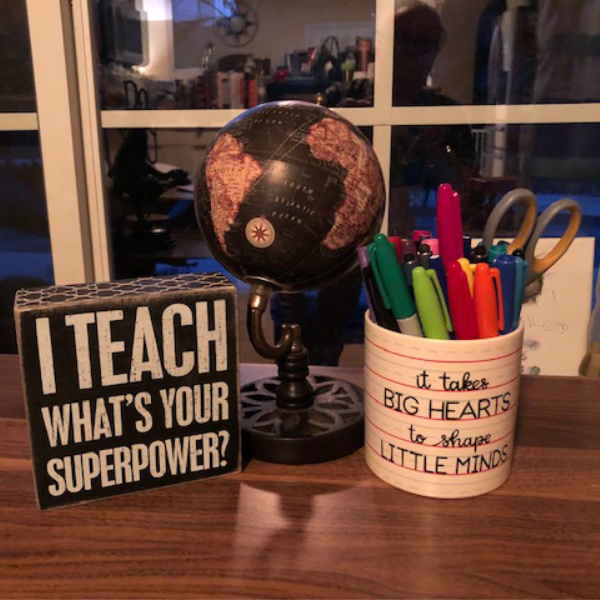The Instructional Benefits of Long-Term Planning! Do you know what they are?

There are instructional benefits of long-term planning. Find out what they are!
Numerous teachers believe that their year is already planned out by the various Teacher’s Editions. But you will also need to review the Common Core or State Standards and to also consider the district’s testing period.
While this may be partially true, there are immense benefits to taking a few hours to actually create your own long-term plan.

Why is it important to plan Long-term?
When you take the time to look at the entire year and the standards that need to be taught and “met” by students, you begin to focus on the things that are the most important to teach. There are definitely benefits to long-term planning.
Let me give you an example.
In some elementary classes you might have to split an hour between Social Studies and Science (and many districts have to do this), how do you plan?
Do you teach each for half an hour? Or do you teach one for a week and then alternate the next week? Do you teach one half the year and then the other?
Can you see how this decision makes a world of difference in how your day and year rolls out?
How to complete a long-term plan!
I’m sure there are numerous ways to complete this type of planning. But I can tell you how I did it.
I would take a regular sheet of paper and divide it into thirds (hamburger style). If you know what I mean by that – then you’ve been teaching for a little while; basically, it is horizontal folds (so there is a top, middle, bottom third).
I would draw the lines (of course, it’s much easier to do this all on computers now-a-days). Then I would make four (4) copies of this for each subject area.
I would then write the months at the top of each section, so that one page has August, September, October. The next page is November, December, and January. The third page is February, March, April. The last page is May, June (and July if you are year-round).
Next, I would list any holidays or vacations for that month (so that you know how many days you have to teach). A month with no holidays has 20 instructional days (they are rare, though).
Are you beginning to see how breaking it all down can really open your eyes to the available days and how it needs to be entirely planned out? And that this extra work will have instructional benefits of long-term planning.
You might be interested in the FREE downloadable list of 101 Teacher Tips. You can get a FREE copy by listing your email below and I will zip it right to you.
**
Let’s talk about the dreaded TESTS!
We have to be realistic and discuss the testing. It’s not going anywhere in the near future. If it ever goes away I will gladly re-write this article.
The reason it is so important to consider the testing is because you have to squeeze the content in before the testing. So, even though it appears you have 10 months in which to teach the state standards, you don’t.
Fortunately, most testing is in the spring. So you have MOST of the year to cover the content (but it will be tight).
Basically, every crucial state standard needs to be taught before testing. After testing you are freed up to include fun projects and casual review of what’s been learned.
Take time to analyze the tests – if possible
Some states have the content of the test listed in percentages tested. If your state has this, it would be super beneficial to take the time needed to review this information.
You would not want to be spending six periods teaching a concept that only has one test question and only one week on the concept that is tested using six questions.
For example, in second-grade students learn homonyms. Teachers may be tempted to spend a large amount of time on this concept. But if your state’s exam only has one or two questions on this and has A LOT MORE questions on consonant blends, then you will want to spend more instructional time on blends.
You can read more about being organized in this article:
Teacher Organization – How to PREPARE and Stay Focused.
Back to looking at the format of the long-term plan!
In my opinion, for elementary
You must also consider if your grade-level has state testing on that particular subject area. For example, some states have a science portion for fifth grade.
When I was teaching I would plan the Science and Social Studies by units so usually we switched subjects every four to six weeks (depending on the length of the unit).
For single-subject teachers, your planning is just more detailed. Perhaps you have different groups learning the subject. For example, you may teach an honors English and also 9th grade and 10th grade. So, in this example, you have three long-term plans to create.

The Next Step
My next step would be to compare the text/content with the standards to ensure that all the standards are included. Then map out the Units in order into the months between the beginning of the year and the testing period.
For both English/Language Arts, Math, and Science it is important to keep the content in the order that the publishers have presented
Are you beginning to notice the instructional benefits of long-term planning?
Make note of some of the “extra” – fun activities that you may not be able to squeeze in during the time allotted. These may be lessons or projects that you can incorporate after the state testing.
Don’t forget the ending units.
As you are planning your subjects, you will notice that you can’t get through the entire text. BUT what you do need to do is take note of what content standards are taught in those lessons that you can’t get to, so that you can move
So, for example, if your final unit in third grade math is on geometry and you can’t squeeze it in to your plans, you need to find a different month to include the parts that are listed in the standards.
When I taught third grade, our team decided to have a double section of math instruction two months before testing in order to get to the every standard.
Please take the time needed to create a long-term plan, you won’t regret it.
Let me know how your planning turned out. Or send me any questions you might have.
Until next time,
Your Teacher Buddy Dawn






